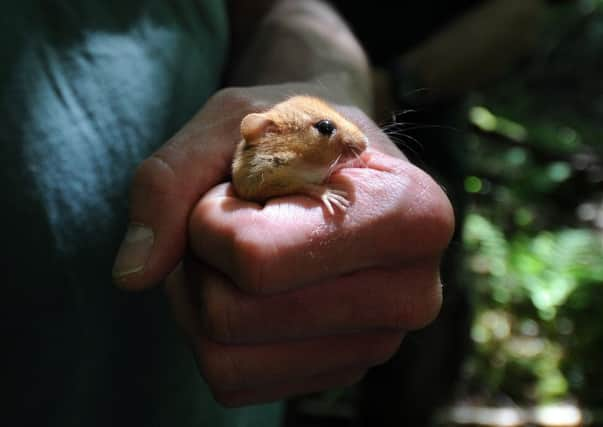Endangered dormice find new home in Yorkshire Dales


It has taken months of planning and the combined expertise of a small army of conservationists and zoologists, but dormice are once again living in a corner of the Yorkshire Dales where they were last thrived a century ago.
Under the watchful eye of Ian White, dormouse officer of the People’s Trust for Endangered Species (PTES), 38 of the tiny creatures were yesterday released into woodland near Aysgarth Falls.
Advertisement
Hide AdAdvertisement
Hide AdThe exact location is being kept secret to allow the new residents a chance to settle in and it is hoped that come the autumn the population will have at least doubled and possibly tripled.
“Numbers have been in steep decline to the point where the once common hazel dormouse was on the brink of extinction,” said Mr White, who has spent the last 10 years trying to ensure their long-term survival. “Partly that’s because many of the woodlands and hedgerows where they lived have disappeared and changes in farming practices have also had an impact. I also wonder whether climate change has played a part.
“Dormice have long periods of hibernation, but because winters are less cold than they were in the past it means they keep waking up when they should be asleep. Each time they lose a little bit of energy and some simply don’t have enough to see them through to spring.”
Immortalised as a sleepy member of the Mad Hatter’s tea party in Lewis Carroll’s Alice’s Adventures in Wonderland, the reintroduction is part of wider efforts to bring the elusive mammal back to sites across England.
Advertisement
Hide AdAdvertisement
Hide Ad“That’s not as easy as it sounds,” added Mr White. “We have to make sure that it is the right kind of woodland, one that will give the dormice the best chance of survival. We tend to do one release each year and this little corner of Yorkshire was an obvious choice, because it is a pretty much a perfect habitat.”
A similar number of dormice were released in 2008 just a mile or so down the road from where this latest population are now making their home and eventually it is hoped the two groups will link up.
“Dormice are what’s know as arboreal creatures,” said Ian Court, the National Park Authority’s wildlife conservation officer, who will be responsible for monitoring the dormice over the coming weeks and months. “That means that they like to be off the ground. The trees and even the dry stone walls of this part of Yorkshire are perfect for dormice, but we are now hoping to secure some extra funding so we can ensure that the kind of habitat they need runs continuously between the two sites.”
Yorkshire’s new dormice were bred in captivity and spent six weeks in quarantine at Paignton Zoo in Devon to ensure they were disease free.
Advertisement
Hide AdAdvertisement
Hide AdOver the next 10 days, Mr Court and a team of volunteers will make daily visits to the temporary dormice cages to feed and water the animals. However, by the start of the next month it is hoped that they will have acclimatised sufficiently to be released fully into the wild.
“We have now released more than 750 dormice at 19 different sites across England,” added Mr White. “These creatures will always be vulnerable and their numbers will never return to what they were in the Victorian age, but they are a part of the English countryside and it’s great to see them back.”